Did you know hummingbirds are the tiniest birds in North America? They weigh less than 3 to 4 grams. That’s lighter than two pennies1! These little birds are amazing, with lots of special skills. They can move their wings so fast it makes a humming sound. That’s not all – they can even fly backward2!
Their nests and how they make them are also incredible. Imagine a nest as small as a half-dollar. Inside, their eggs look like jellybeans. These nests show how clever nature can be.
Key Takeaways
- Hummingbirds are the lightest North American birds, weighing less than two pennies1.
- They are the only birds capable of flying backward2.
- Hummingbird nests are often smaller than a half-dollar and contain jellybean-sized eggs.
- With over 340 species, all unique to the Americas1.
- Hummingbirds have superb visual acuity, assisting in their nest construction1.
- Understanding hummingbird nests provides insight into their resilience and resourcefulness.
Introduction to Hummingbird Nests
Hummingbird nests are both fascinating and intricate. Female hummingbirds craft these tiny structures. They use natural materials for their offspring’s safety and growth.
Each part of the nest shows the birds’ remarkable skills. It shows how adaptable these tiny birds are too.
Why Hummingbird Nests Are Unique
Hummingbird nests are tiny, no bigger than a half-dollar coin3. They mix plant down and spider silk for softness and flexibility3. This elasticity lets the nest grow as the babies get bigger4.
Female hummingbirds make nests 10–40 feet up in trees. This keeps them safe from many predators4.
The Importance of Understanding Hummingbird Nests
Knowing about hummingbird nests helps us appreciate their precision. Spider silk binds the nest, adding strength3. Plant down insulates, keeping eggs and chicks warm3.
Understanding nest construction supports conservation. It helps these beautiful creatures thrive.
How Hummingbirds Build Their Nests
Female hummingbirds lead the nest building. This process takes several days of hard work. Each day, the female works for hours, using various materials.
Materials Used in Hummingbird Nest Construction
The nests are made from twigs, leaves, moss, lichen, and spider silk. The female chooses these materials for strength and flexibility. Spider silk is key, letting the nest stretch as babies grow5. The size of nests changes with the bird’s size5.
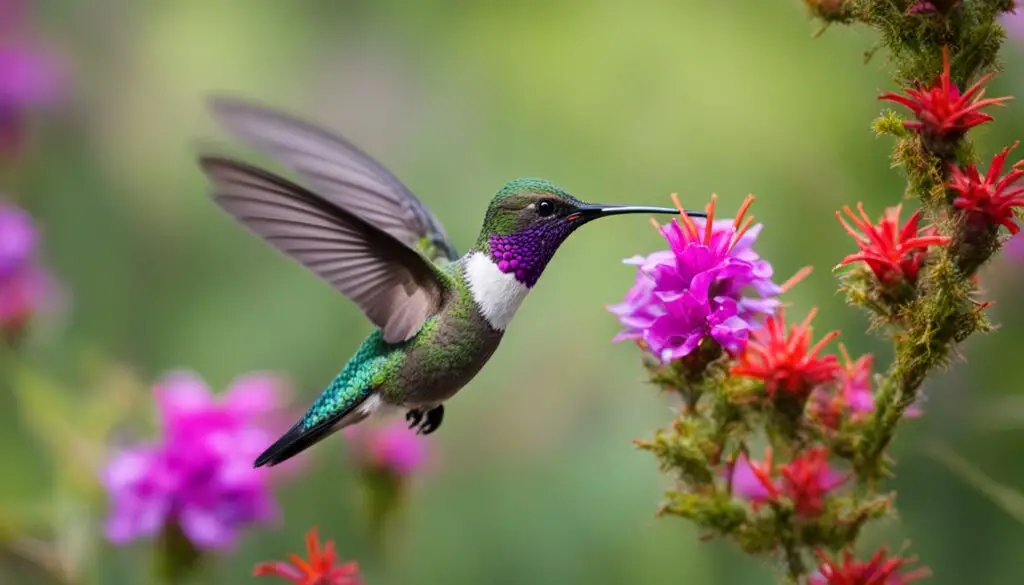
The Process of Nest Building
It takes 6 to 10 days to build a nest4. The female fixes the nest to a slanted twig or branch6. This helps hide and stabilize the nest. The nest is just over an inch wide5. Sometimes, a new nest is built atop an old one6.
The Role of Female Hummingbirds in Nest Building
The female hummingbird builds nests alone, showing her dedication. She carefully places each piece. This task is vital for her chicks’ survival. Costa’s hummingbirds might build many nests close together at the best spots6.
The Best Materials for Hummingbird Nests
Creating a comfortable, safe spot for hummingbirds is important. They pick materials that are strong, bendy, and not heavy. By placing safe materials in your garden, you help hummingbirds do well.
Natural Resources and Their Benefits
Hummingbirds use many different natural materials to build their nests. They really like spider silk because it stretches. This lets the nest grow as the baby birds get bigger5. They also use small sticks, leaves, moss, and lichen, which are easy to find and very strong5. By offering these resources, you make a better place for them to nest.
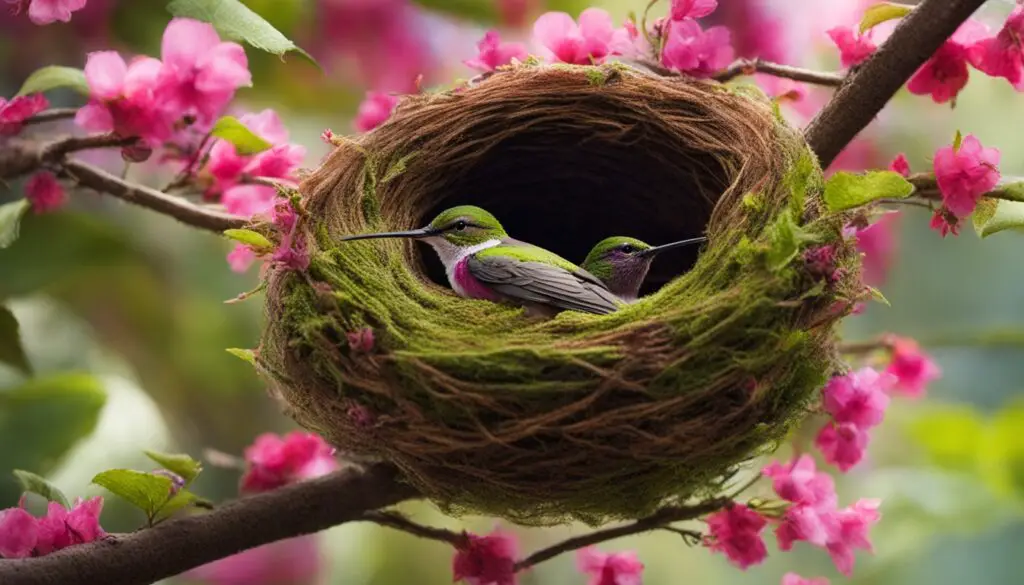
How to Source Safe and Effective Materials
To get the right materials, you could grow a garden full of them. Giving hummingbirds good nesting materials makes their lives easier and helps them survive7. Stay away from things treated with chemicals or that have long threads. Those can hurt the birds7. Having lots of natural materials creates a great environment for them.
Attracting Hummingbirds to Build Nests
To get hummingbirds to nest in your yard, think about what they like. Use nectar-rich flowers and feeders. This makes them want to stay and raise their young ones.
Planting the Right Flowers
Choosing the right flowers is key to bringing hummingbirds to you. Bee balm, sage, and honeysuckle are top picks. These plants are like fast-food for them, offering lots of nectar8.
Hummingbirds visit many flowers each day to eat enough. So, having lots of these plants means they won’t go hungry9. They love bright colors like red and purple. That’s why picking these colors can help8.
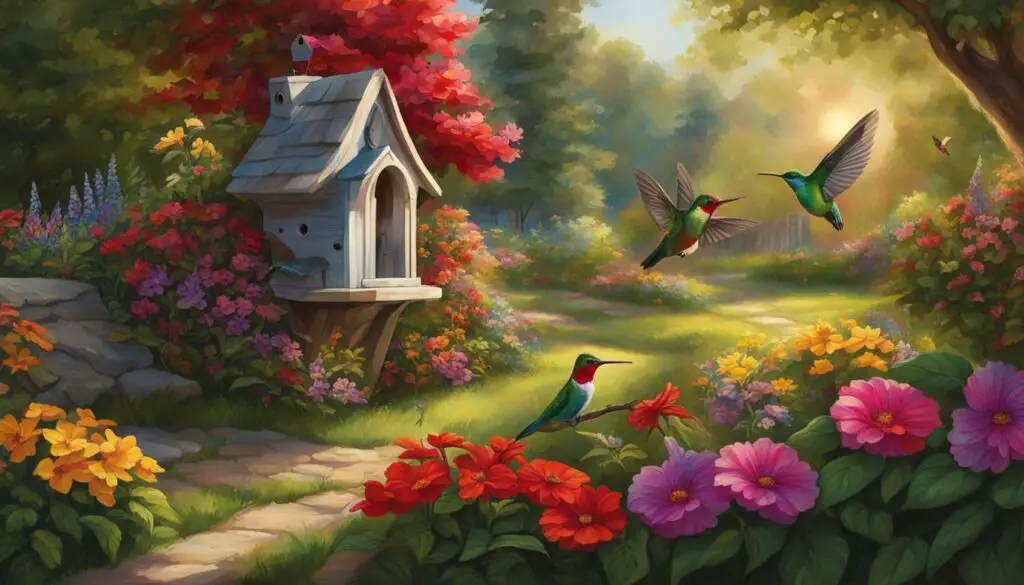
Setting Up Nectar Feeders
Adding nectar feeders helps too. You can make nectar with sugar and water8. Place these feeders near bright colors. It helps hummingbirds find them easily8.
Hummingbirds build nests near their food. So, putting feeders in the right spots is smart9.
Start with a couple of feeders to not attract too many birds. This keeps them comfortable. Keeping the nectar clean and natural helps too. This way, your yard becomes perfect for nesting hummingbirds.
Common Hummingbird Nest Locations
Choosing where to nest is very important for hummingbirds. They like trees and shrubs that keep them safe and close to food.
Preferred Trees and Shrubs
Female hummingbirds make their nests from 10 to 90 feet up. They pick spots in trees or shrubs that have lots of cover. They also need strong branches to support them. They often pick small shrubs, tall trees, and even cacti in dry areas. Ruby-throated hummingbirds use spider silk to stick their nests to twigs that lean6.
Trees like oak, birch, and eucalyptus are favorites. They provide good nesting materials and support6. A hummingbird nest is tiny, only about an inch wide. It looks like a small wood knot. This is because they use lichen, moss, and spider silk to build it5.
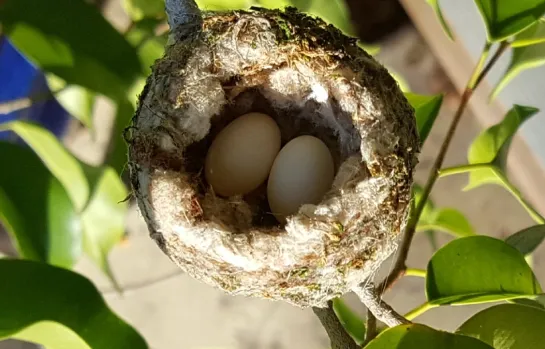
Impact of Climate and Environment on Nest Location
Where hummingbirds nest is greatly affected by the climate. Warm climates can start breeding in March. But in colder places, it can start as late as July5.
Adapting to different environments is key. For example, Costa’s hummingbirds can have up to six nests close to each other6. Now, they even nest in cities, finding places to eat and live. However, it is against the law to disturb a nest in the U.S. This shows how we need to protect them5.
Protecting and Preserving Hummingbird Nesting Habitats
Helping hummingbirds find safe nesting areas is key. By designing your garden with care, you help them live well all year. This means gardens can be a haven for these tiny birds.
Garden Design Tips
Pick plants that give shelter and lots of nectar for a hummingbird-friendly garden. Use Beebalms, Coral honeysuckle, and Cardinal flower, as advised by Hummingbirds at Home10. Stay away from chemicals that harm hummingbirds8. Use bright colors like red, orange, and pink to attract them8.
Safe Practices for Observation
Watching hummingbirds safely is about being careful not to bother them. Clean feeders often to stop disease. Make nectar with 1/4 cup sugar to 1 cup water, no dye8. Offer misters for them to enjoy without too many birds gathering8. Watch them from afar to keep their nests safe5.
Fun Facts About Hummingbird Nests
Hummingbird nests are small wonders, blending skill with what nature offers. They’re hard to see because they are so small and blend in.
Size and Structure of Hummingbird Nests
Hummingbird nests are about an inch wide. They’re made of twigs, leaves, moss, lichen, and spider silk5. The female works for up to seven days to make it right. This makes the nest grow as the babies do5. You can find nests on thin branches or in thick bushes5.
The Tiny Eggs: Size and Quantity
Usually, a hummingbird lays two small eggs. They need 15 to 18 days to hatch6. The eggs look like jellybeans. Anna’s hummingbirds may nest as early as December in the right spot6.
Surprising Facts About Hummingbird Babies
After they hatch, young hummingbirds stay in the nest for 18 to 28 days6. They get ready for their first big trip. Black-chinned hummingbirds have deep nests to keep chicks safe. The edges may curl in to protect them6. Broad-tailed hummingbirds often come back to the same place every year6.
In short, learning about hummingbird nests shows us how careful these birds are. They pick the best materials and places. This helps their little ones grow up safe.
How to Make a Hummingbird Nest
Making a home for hummingbirds is rewarding. You need to know what they like for nesting. Picking right materials lets you welcome these birds to your yard.
Step-by-Step Guide
First, collect soft, stretchy materials. Moss and spiderwebs are great. They make the nest stable and flexible. Use cattail fluff or buy organic cotton stuffing7. Here’s how to start:
- Prepare the Base: Find a small, strong spot, like a tree branch or a protected bush.
- Weaving the Nest: Bind moss and lichen with spiderwebs. This lets the nest expand as chicks grow.
- Add Extra Softness: Put in more soft stuff, like organic cotton or natural nest kits7.
- Finishing Touches: Make it pretty with grapevine balls from craft stores7.
Common Pitfalls and How to Avoid Them
To make a safe nest, don’t use dryer lint or pet hair. These might harm the birds7. Picking the right spot is key. Choose areas that keep the nest safe from predators and bad weather7. Use natural, safe materials for their wellbeing7.
Know what female hummingbirds do. They build the nest and care for the babies alone. Males don’t help11. Make the nest hidden and blend in with lichen for better chances of use11.
Making a hummingbird nest guide can be fun. It also helps bring these beautiful birds to your garden. By using the best materials and locations, you give them a welcoming and safe place.
Adapting Your Garden for Hummingbird Nests
To welcome hummingbirds, create a friendly space with flowers full of nectar and good spots for nests. These changes will turn your garden into a perfect spot for these amazing birds.
Best Plants and Flowers to Attract Hummingbirds
Plant flowers that bloom at different times to give hummingbirds nectar all season. They love flowers with deep tubes and bright colors like red, orange, and pink. Go for plants like Agastache rupestris, Aquilegia canadensis, Beebalm (Monarda), Scarlet Sage (Salvia coccinea), and Honeysuckle (Lonicera) because they’re great for nectar1210.
Having different flowers for hummingbirds makes your garden welcoming. Native plants like trumpet honeysuckle, bee balm, and hummingbird sage have more nectar than others. This makes them better for attracting hummingbirds10. The Hummingbirds at Home program found that between 2013 and 2021, these birds liked about 371 plant types, showing they enjoy a variety10.
Hummingbirds also like a safe place with lots of perches, insects for food, and clean water. You can put up feeders with sugar water to add to the nectar they find. If your neighbors do the same, it helps hummingbirds even more. This support is great for their nesting and feeding10.
Conclusion
Hummingbird nests are truly amazing. They are tiny but show great skill in how they’re made. The nests use things like spider silk so they can get bigger when baby birds grow. This keeps the babies safe as they get bigger3. It’s important to watch them quietly and follow rules to protect their homes. If we’re not careful, we could scare them away, which is bad for the baby birds13.
You can help hummingbirds right from your home. By growing flowers that they like and putting up feeders, you make a safe place for them. You also need to think about where they build their nests, like in safe, high spots3. Doing this is good for the hummingbirds and helps all kinds of life in your area. It makes our world richer and more diverse.
Helping wildlife like hummingbirds means we’re really working to save them. We do this by making sure they have what they need, from the right plants to quiet spaces. This way, these beautiful birds will be around for a long time, making our skies more wonderful133. When we care for hummingbird nests, we’re doing something good for our planet and everything living on it.
Source Links
- https://www.birdsandblooms.com/birding/attracting-hummingbirds/13-jaw-dropping-facts-about-hummingbirds/
- https://www.kaytee.com/learn-care/wild-bird/hummingbird-facts
- https://sparklark.com/know-about-hummingbird-nests/
- https://www.allaboutbirds.org/guide/Ruby-throated_Hummingbird/lifehistory
- https://abcbirds.org/blog21/hummingbird-nests/
- https://www.birdsandblooms.com/birding/attracting-hummingbirds/hummingbird-nest-facts/
- https://thehummingbirdfeeder.com/how-to-get-hummingbird-nests-in-your-yard/
- https://www.thespruce.com/attract-nesting-hummingbirds-386412
- https://www.nature-anywhere.com/blogs/bird-feeding-academy/the-secret-guide-to-hummingbird-nests-in-your-garden
- https://www.audubon.org/community-science/hummingbirds/how-create-hummingbird-friendly-yard
- https://jaysbirdbarn.com/hummingbird-nesting-behavior/
- https://hort.extension.wisc.edu/articles/hummingbirds-in-the-garden/
- https://www.hummingbird101.com/what-happens-if-you-disturb-a-hummingbird-nest/

My name is Shane Warren, the author behind Your Bird Buddy – your ultimate guide to the wonderful world of birds! Unleash your inner avian explorer as we delve into a vibrant library of knowledge dedicated to all things feathered. From learning about diverse bird species from across the globe to understanding their captivating habitats and behaviors, I’m here to fuel your passion for these magnificent creatures. Not only that, but I also provide valuable insights on being a responsible and informed pet bird owner. Join our vibrant community and let’s celebrate the feathered wonders of the world together – one chirp at a time. And be sure to join our Your Bird Buddy Community over on Facebook!

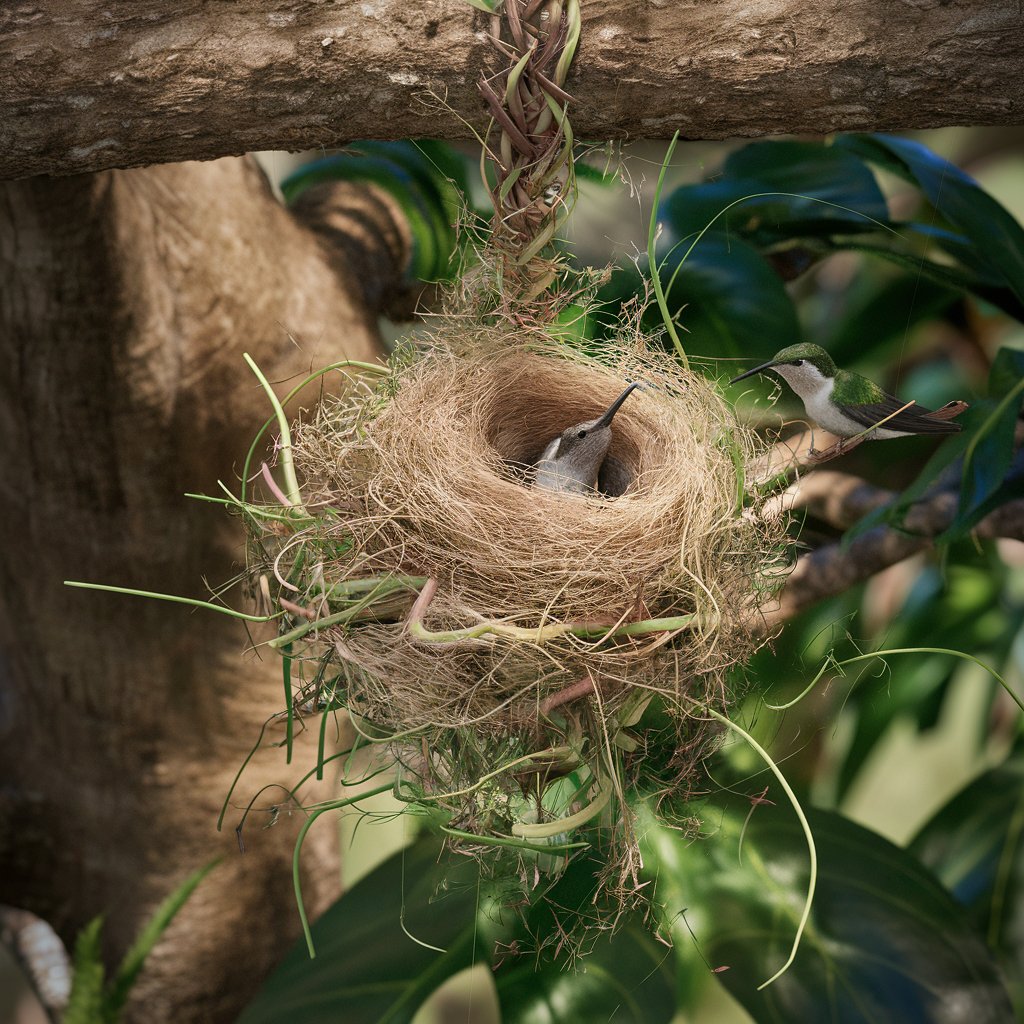
Comments are closed